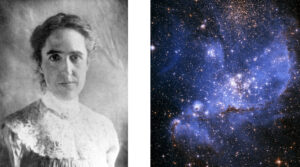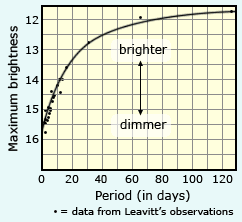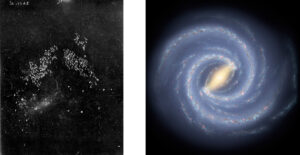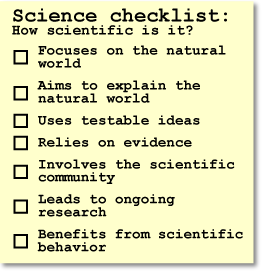
Compare this example — an astronomical breakthrough kicked off by the work of Henrietta Leavitt — to the science checklist, and see how you think it measures up:
![]() Focuses on the natural world?
Focuses on the natural world?
Henrietta Leavitt focused her curiosity on the stars in the sky. In 1893, she began work as a volunteer at Harvard College Observatory, collecting and analyzing data on the position, brightness, and color of stars. Leavitt’s most important work focused on variable stars — stars whose brightness changes regularly over time, slowly shifting between brilliant and dim.

![]() Aims to explain the natural world?
Aims to explain the natural world?
This work was part of a larger project to survey the stars in order to learn more about how they work — what they are made of, why they are different from one another, how they produce energy, etc. Leavitt discovered that the period of a variable star — the length of time required for a star to go from its brightest to its dimmest point and then back again to the brightest (you can think of this as the star’s blinking rate) — is related to the star’s intrinsic brightness. At the time, no one had an explanation for this unexpected revelation.
![]() Uses testable ideas?
Uses testable ideas?
Leavitt’s idea that the blinking rate of variable stars is related to their intrinsic brightness was inspired by her observations of the clustered stars in the Small Magellanic Cloud. Brighter stars in this cloud had predictably slower blinking rates than dimmer stars. This research project focused on a single cluster of stars; however, the idea could be tested by studying the many other clouds of variable stars in the universe and figuring out if their brightness and blinking rate fit the same rule.
![]() Relies on evidence?
Relies on evidence?
Leavitt’s ideas were supported by her meticulous observations and measurements of the brightness of variable stars, as recorded on photographic plates from a telescope in Peru.
![]() Involves the scientific community?
Involves the scientific community?
In 1912, Leavitt’s observations and analysis were published in the Circular of the Astronomical Observatory of Harvard College. In this publication, many other astronomers were able to read about and build on her ideas.
![]() Leads to ongoing research?
Leads to ongoing research?
Once the relationship between blinking rate and luminosity and the relevant evidence were published, other astronomers seized upon the idea as the key to estimating cosmic distances. In 1913, Ejnar Hertzsprung figured out how to calibrate the relationship in order to estimate distances to far-off stars. Soon after, Harlow Shapley used the idea to estimate the size of the Milky Way galaxy. And in 1929, Edwin Hubble used the idea to get key results suggesting that the universe is expanding.

![]() Researchers behave scientifically?
Researchers behave scientifically?
Throughout the data-gathering, analysis, testing, and communication described above, Leavitt acted with scientific integrity, accurately reporting her data, viewing the evidence objectively, and making her ideas and evidence known to the scientific community so that others could evaluate and build upon them.
Now it’s up to you. How does Henrietta Leavitt’s investigation of variable stars measure up to the science checklist?

Explore archival material about Henrietta Swan Leavitt and early female astronomers Williamina Fleming, Cecilia Payne-Gaposchkin, and Annie Jump Cannon, courtesy of the Smithsonian Learning Lab.
